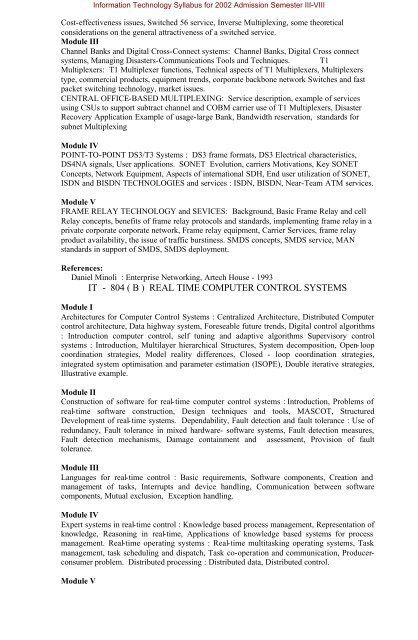Information Technology Syllabus for 2002 Admission Semester III
Information Technology Syllabus for 2002 Admission Semester III
Information Technology Syllabus for 2002 Admission Semester III
You also want an ePaper? Increase the reach of your titles
YUMPU automatically turns print PDFs into web optimized ePapers that Google loves.
Cost-effectiveness issues, Switched 56 service, Inverse Multiplexing, some theoretical<br />
considerations on the general attractiveness of a switched service.<br />
Module <strong>III</strong><br />
Channel Banks and Digital Cross-Connect systems: Channel Banks, Digital Cross connect<br />
systems, Managing Disasters-Communications Tools and Techniques. T1<br />
Multiplexers: T1 Multiplexer functions, Technical aspects of T1 Multiplexers, Multiplexers<br />
type, commercial products, equipment trends, corporate backbone network Switches and fast<br />
packet switching technology, market issues.<br />
CENTRAL OFFICE-BASED MULTIPLEXING: Service description, example of services<br />
using CSUs to support subtract channel and COBM carrier use of T1 Multiplexers, Disaster<br />
Recovery Application Example of usage-large Bank, Bandwidth reservation, standards <strong>for</strong><br />
subnet Multiplexing<br />
Module IV<br />
POINT-TO-POINT DS3/T3 Systems : DS3 frame <strong>for</strong>mats, DS3 Electrical characteristics,<br />
DS4NA signals, User applications. SONET Evolution, carriers Motivations, Key SONET<br />
Concepts, Network Equipment, Aspects of international SDH, End user utilization of SONET,<br />
ISDN and BISDN TECHNOLOGIES and services : ISDN, BISDN, Near-Team ATM services.<br />
Module V<br />
FRAME RELAY TECHNOLOGY and SEVICES: Background, Basic Frame Relay and cell<br />
Relay concepts, benefits of frame relay protocols and standards, implementing frame relay in a<br />
private corporate corporate network, Frame relay equipment, Carrier Services, frame relay<br />
product availability, the issue of traffic burstiness. SMDS concepts, SMDS service, MAN<br />
standards in support of SMDS, SMDS deployment.<br />
References:<br />
Daniel Minoli : Enterprise Networking, Artech House - 1993<br />
IT - 804 ( B ) REAL TIME COMPUTER CONTROL SYSTEMS<br />
Module I<br />
Architectures <strong>for</strong> Computer Control Systems : Centralized Architecture, Distributed Computer<br />
control architecture, Data highway system, Foreseable future trends, Digital control algorithms<br />
: Introduction computer control, self tuning and adaptive algorithms Supervisory control<br />
systems : Introduction, Multilayer hierarchical Structures, System decomposition, Open-loop<br />
coordination strategies, Model reality differences, Closed - loop coordination strategies,<br />
integrated system optimisation and parameter estimation (ISOPE), Double iterative strategies,<br />
Illustrative example.<br />
Module II<br />
Construction of software <strong>for</strong> real-time computer control systems : Introduction, Problems of<br />
real-time software construction, Design techniques and tools, MASCOT, Structured<br />
Development of real-time systems. Dependability, Fault detection and fault tolerance : Use of<br />
redundancy, Fault tolerance in mixed hardware- software systems, Fault detection measures,<br />
Fault detection mechanisms, Damage containment and assessment, Provision of fault<br />
tolerance.<br />
Module <strong>III</strong><br />
Languages <strong>for</strong> real-time control : Basic requirements, Software components, Creation and<br />
management of tasks, Interrupts and device handling, Communication between software<br />
components, Mutual exclusion, Exception handling.<br />
Module IV<br />
Expert systems in real-time control : Knowledge based process management, Representation of<br />
knowledge, Reasoning in real-time, Applications of knowledge based systems <strong>for</strong> process<br />
management. Real-time operating systems : Real-time multitasking operating systems, Task<br />
management, task scheduling and dispatch, Task co-operation and communication, Producerconsumer<br />
problem. Distributed processing : Distributed data, Distributed control.<br />
Module V<br />
<strong>In<strong>for</strong>mation</strong> <strong>Technology</strong> <strong>Syllabus</strong> <strong>for</strong> <strong>2002</strong> <strong>Admission</strong> <strong>Semester</strong> <strong>III</strong>-V<strong>III</strong>
















